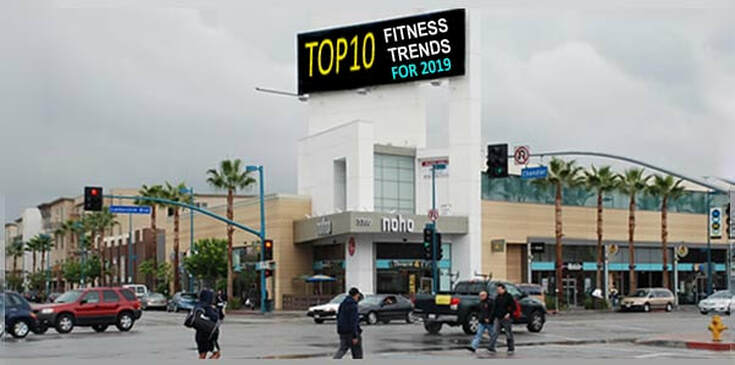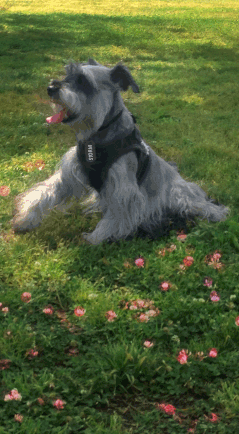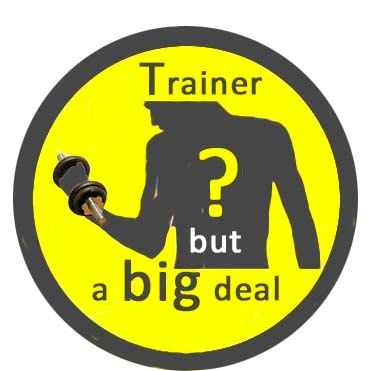|
Samba balances his energy with two daily walks.
He keeps fit and socialized by running and playing in the park three times a week. |
Lifestyle Find Yours.
Samba in front, followed by his friend Batucada. |
|
Today, I wanted to address a question that I often receive due to my fitness brand, GO6PACK Fitness.
Many of you have reached out and asked me about the timeline for developing six-pack abs. I wanted to take this opportunity to share my answer, which remains consistent and reflects the realistic approach I take in my training programs.
0 Comments
Since 2006, the American College of Sports Medicine (ACSM) have conducted a survey to predict future health and fitness trends for the following year. The survey conducted is used to help predict trends in both fitness and wellness for the following year with responses from those who work in the health and fitness industry, while also identifying fads, or activities/workout styles that are only relevant for a short period. Highlights of the 2019 annual survey of health and fitness trends included: 1. Wearable TechnologyWearable technology was at the top-ranked position it had occupied for two consecutive years, before dropping to number three in last year’s survey. The return of wearables might be due to the result of manufacturers correcting some monitoring inaccuracies of the past. 2. Group TrainingGroup training, defined as classes of more than five participants, was rated number two for the second year in a row. Small group training has been gaining popularity because it’s an affordable, fun way for clients to take advantage of a trainer’s expertise at a lower financial investment — all while keeping the fun and competitiveness of a group dynamic. 3. high-Intensity Interval Training (HIIT)Third in the league is, high-intensity interval training (HIIT), referring to short bouts of workout followed by a short rest period. 4. Fitness Programs for Older AdultsFitness programs for older adults has made a strong return to the top 10 in recent surveys. “Older adults” typically refers to anyone age 65 years or older, but it is important to realize that this age group includes a wide range of fitness and health needs. 5. Body Weight WorkoutsBody weight workouts for a bodyweight practitioner a strong core is the key to build body strength. Be brave and abandon the stability which most weights machines offer. Instead, hit the floor and perform your press ups unilaterally, on one leg or with one arm. You’ll find the added degree of difficulty recruits more muscle fibers, engages the core and gets the different muscles in the body working cohesively. 6. Certified Fitness ProfessionalsRanked sixth in the order, is employing certified fitness professionals – certified by ACSM or other nationally accredited organizations replacing “educated, certified, and experienced fitness professionals,” 7. YogaWith the increasing rise in different forms of yoga like the Power Yoga, Yogalates, yoga in hot environments, and others it has for the first time appeared in the top 10 in this survey after 2016. 8. Personal Training. With increasing demand, personal training has become more accessible online, in health clubs, in the home, and in worksites that have fitness facilities. Personal training includes fitness testing and goal setting with the trainer working one on one with a client to prescribe workouts specific to each client’s individual needs and goals. 9. Functional Fitness TrainingFunctional fitness training. There is a trend toward using strength training and other activities/movements to improve balance, coordination, strength, and endurance to improve activities of daily living. Replicating actual physical activities someone might do it as a function of their daily routine depending on the need. Functional fitness also is used in clinical programs to replicate activities done around the home. 10. Exercise is MedicineIt is a global health initiative that is focused on encouraging primary care physicians and other health care providers to include physical activity assessment and associated treatment recommendations as part of every patient visit and referring their patients to exercise professionals. In addition, EIM recognizes fitness professionals as part of the health care team in their local communities.
Trends dropping out of the top 20 since the previous survey were circuit weight training, sport-specific training, and core training. 04/25/2007 - 01/25/2018Today I had to say bye to Storm and this poem came to my mind with the hope that one day I will see my friend again.
1 - Place things back where you found them and re-rack your weights. Everything in a gym has its place. It doesn’t matter if it’s a dumbbell, weight plate, or medicine ball. If you’ve used it, always be considerate and put it right back where you found it when you’re finished. If you can lift it, you can put it away. Re-rack your weights. This is simply picking up after you. Something we all learn to do as children. It takes very little effort and helps the next person. Some people might say that the person before them left the weights scattered around so they are just leaving it the way they found it. That leads us to our next item.
2 - Re-rack someone else’s weights. It won’t kill you to pick up a small area you are in. Lead by example. If someone left your area unorganized then organize it when you are putting your weights up. It only makes sense. Who cares if you didn't make the mess? Be better than that. Most people who have a normally functioning brain will feel bad seeing you pick up after them and won’t make the same mistake again. 3 - Equipment use. Allow others to work-in when you are between sets on strength equipment. Offer other members work-in when you are on the equipment and if you are waiting for the equipment ask other members if you can work-in. Please refrain from reserving equipment with a towel or resting on equipment between sets. Please limit your use of cardio equipment to 30 minutes during peak times if other members are waiting. 4 - Give your equipment to people who need it more than you. If you are doing curls out of a squat rack for convenience there is nothing wrong with that. However, if someone is waiting to squat it is a deadly sin. Squat racks are for squatting. Equipment with two cable arms is for use of cable arms and not to hang a TRX, unless nobody else is at the gym. The same goes for deadlifting in front of a rack. You can deadlift anywhere. So you have to walk a few extra steps with weight. You are in a gym. Don’t be lazy. And don’t hold the same equipment for long time or different exercises unless there is another one available. Keep in mind the gym is not your own private gym. 5 - Cell phone use. This is one of the most common and annoying behavior in the gyms. Limit your cell phone use to music while working out. If you can’t resist and want to text, email, or make a phone call while you are resting between sets, then step aside from the equipment and allow others to use it while you rest and use your cell phone. 6 - Dropping weights. Maintain control of weights at all times and safely lower to resting position or storage racks. Please do not drop weights from overhead or let drop from waist level to the ground. Act like it’s your own equipment. 7 - Wipe down the benches and seats you use. Gyms are breeding ground for bacteria. Additionally no one wants to deal with your sweat grease. 8 - Don’t be an intimidating idiot. No one cares how big you are or how much weight you can lift. Everyone starts somewhere. Just because you have 15 years of experience under your belt you don’t have to make the 15 year old feel more stupid that he or she already does trying to work out for the first time. You aren’t in the gym to put on a show. You are there to workout. So is everyone else. 9 – Don’t train right in front of the weight rack. Normally the person lifting weights has the right-of-way. But when you choose to perform one-armed rows with one hand on the rack or you grab two dumbbells for biceps curls and step back only two inches, you prevent others from accessing the weights. Your best bet is to grab the weights you need and retreat to an area where you can exercise but not obstruct traffic. And remember to re-rack them when you’re finished with your set. 10 – Save the grunts and groans for home. Grunting or shouting as you lift weights doesn't just frustrate other exercisers around you; it leaves you looking like you want other people to notice you. And trust us, they will, but not in the way you want them to. If you find yourself making noises unintentionally, try pursing your lips as you lift and breathe properly exhaling as you raise the weight and inhaling as you lower it. 11 – Sharing your music with everyone. Music is essential for many gym-goers. Nothing gets the blood pumping like “Vulgar Display of Power” on max, and almost everyone you’ll see at the gym will have headphones in. But there are some people who prefer to use the speakers on their phone or like to sing along. Be aware of your music volume, and be sure to wear headphones. Don’t randomly break into song or start rapping, either. Keep your music to yourself. 12 – Water paper cup. And last but not least, specially tailored for the NOHO 14 gym users, before you leave the gym throw away your water cups. I've been working in gyms and fitness centers for almost two decades and lifted in gyms for twice as long. I’ll say that these rules of gym etiquette aren’t just for newbies. If you have been going to a gym for a long time and find that you’ve done many of these things in the past (or you still do them) that’s okay! We all learn, and we get better. While you can’t make others change, you can change yourself. If you do, hopefully others will follow your example. So here are some items of what I consider proper gym etiquette. “History will talk about a Rio de Janeiro before and after a much better Rio de Janeiro after the Olympic Games", said International Olympic Committee (IOC) President Thomas Bach at the closing ceremony of the Olympic Games Rio 2016. Indeed, a unique legacy will be left these games to current and future generations of Cariocas and Brazilians, which touches multiple facet's of people daily lives. The sporting legacy will naturally be an important one from the Olympic Games Rio 2016, with new world-class sports venues to be used by elite and grassroots athletes. For example:
Rio de Janeiro has used the Olympic Games as an important catalyst to improve its public transport infrastructure, with the population that will have access to high capacity public transport up from 18 per cent in 2009 to 65 per cent at the end of this year. This is thanks to:
There will also be an educational legacy from the Olympic Games Rio 2016, with infrastructure and knowledge both gained during Rio’s time as a host city. Cariocas and Brazilians will be able to benefit from:
The Games have also brought an economic legacy to the city and country. An independent study by the Fundation Getulio Vargas showed that Rio enjoyed the best and most socially equitable development of any city in Brazil during the period of the Games preparations. Beyond the direct investment through construction and jobs for the Games, the economic legacy will also be felt thanks to:
Finally, the Olympic Games have also delivered an important legacy of an increase in national unity and pride from the successful hosting of marvelous Games.
There is no doubt that the legacy of Rio 2016 will live on for a long time to come. REFERENCE: https://www.olympic.org
|
Our Blog Has Fitness, Nutrition and Lifestyle Articles.
|






